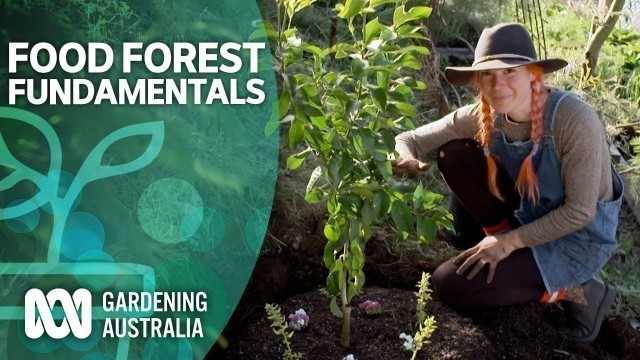

'Hannah demonstrates the food forest concept in her Hobart garden on Muwinina Country. She takes a multi-layered approach to her productive planting and mimics a forest ecosystem. A food forest mimics the diversity of a natural forest where a variety of plants grow together as an ecosystem. By modelling this concept in the garden, plants grouped together complement each other, take advantage of niches and microclimates, increase biodiversity and ensure healthy soil and plants. And it looks beautiful. And part of it is about providing food to humans. At Hannah’s place she is establishing a food forest on the pallet bank garden. It’s where she is layering fruit and nut trees with shrubs, groundcovers, vines, root crops and herbaceous plants. 00:48 | Food forest layers In theory a food forest has seven layers: canopy layer (large fruit trees), understorey (smaller nut and fruit trees), shrubs (berries and large perennials), herbaceous (herbs and plants), rhizosphere (root crops), groundcover (clover and strawberries) and vines (climbing beans, peas etc.). You don’t have to have all seven layers for the plants to benefit from each other though, as Hannah shows in her garden, where there isn’t room for a canopy. But each plant is still chosen to provide at least three uses in a garden - such as a plum tree providing fruit, food for the bees, plus wind shelter for other plants. 01:27 | How to plant a food forest Hannah plants out a three-layer donut-shaped mini forest that can fit into a pot of small courtyard. She plants a lemon tree with warrigal greens in a circle around the base; this will spread down the slope creating a ground cover while providing fresh greens. Inside the warrigal circle she plants Sweet Alyssum flowers to attract pollinators and beneficial insects. The idea is to maximize production while minimising maintenance. Featured plants: Greengage plum (Prunus domestica cv.) Lemon (Citrus cv.) Warrigal greens (Tetragonia tetragonioides) Sweet Alyssum (Lobularia maritima cv.) See the latest content from Gardening Australia as it goes live by hitting subscribe: http://ab.co/GA-subscribe Watch Gardening Australia on ABC iview: http://iview.abc.net.au/programs/gardening-australia About Gardening Australia: Gardening Australia is an ABC TV program providing gardening know-how and inspiration. Presented by Australia\'s leading horticultural experts, Gardening Australia is a valuable resource to all gardeners through the television program, the magazine, books, DVDs and extensive online content. Connect with other Gardening Australia fans: Like Gardening Australia on Facebook: http://www.facebook.com/gardeningaustralia Follow Gardening Australia on Instagram: http://www.instagram.com/gardeningaustralia Visit the Gardening Australia website: http://www.abc.net.au/gardening This is an official Australian Broadcasting Corporation YouTube channel. ******** Contributions may be removed if they violate ABC\'s Online Conditions of Use http://www.abc.net.au/conditions.htm (Section 3).'
Tags: how to , plants , Natural , abc , garden , sustainable , gardening , all natural , efficient , permaculture , eco-friendly , horticulture , gardening australia , gardening tips , gardening advice , abc tv , planting , food production , chemical free , organic farming , fresh produce , food forest , Food crops , multi-layer planting , Hobart Tasmania , terraced garden , cool temperate garden , farming basics , introduction to food forest , beginners farming , maximise efficiency , happiness is , alternative farming
See also:
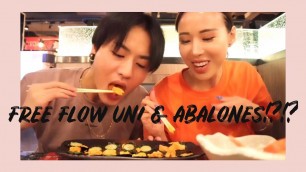


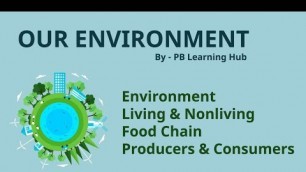


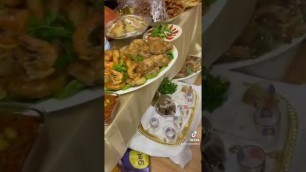
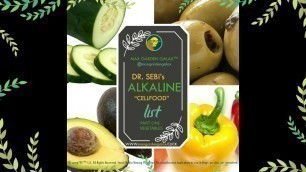
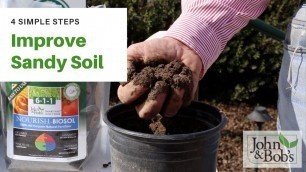



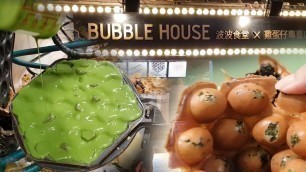



!['Space Food Truck Ship: Space Haven Alpha 10 [EP1]'](https://cdn-img01.food2blog.com/images/44-m/500/500248_m.jpg)
comments